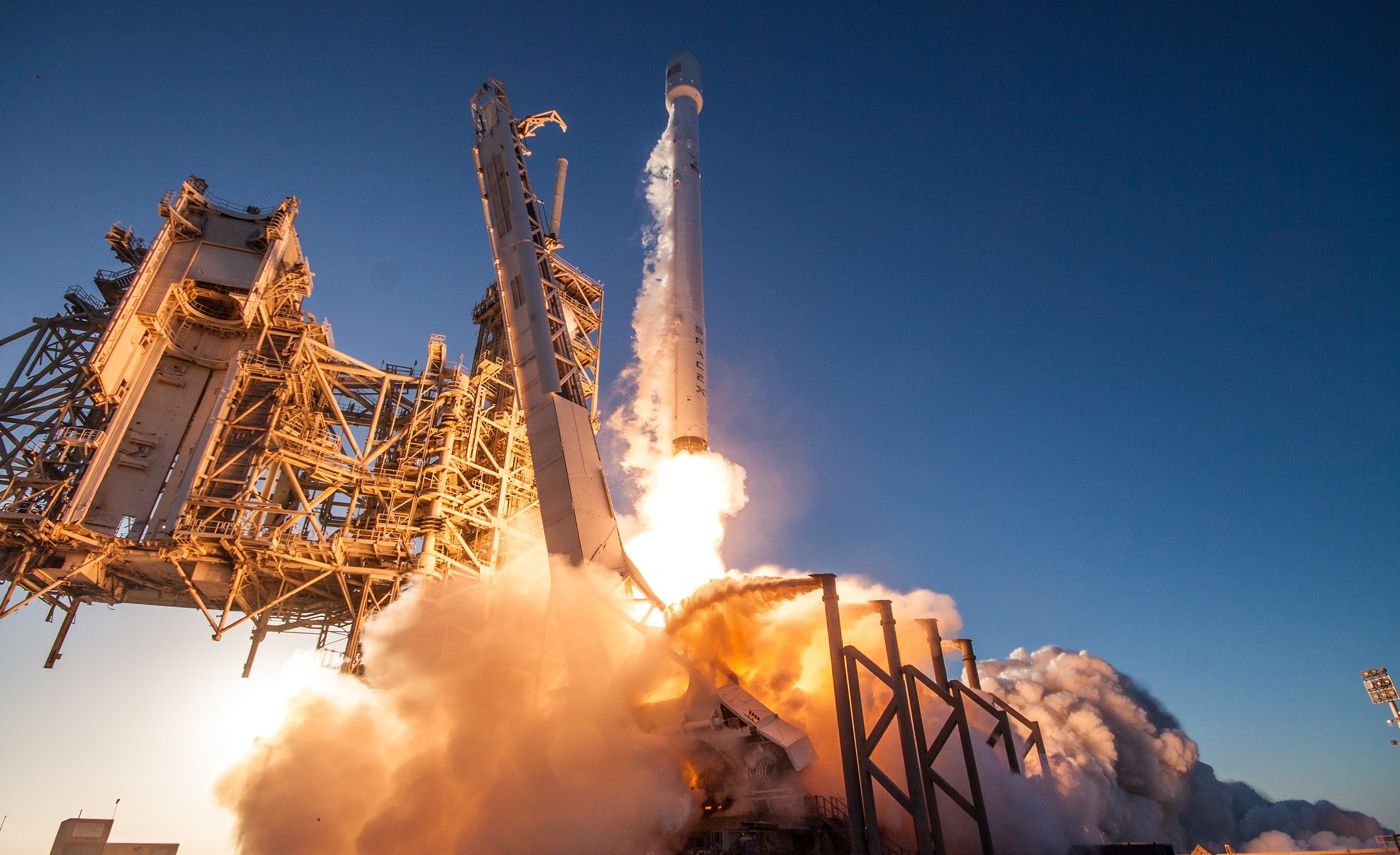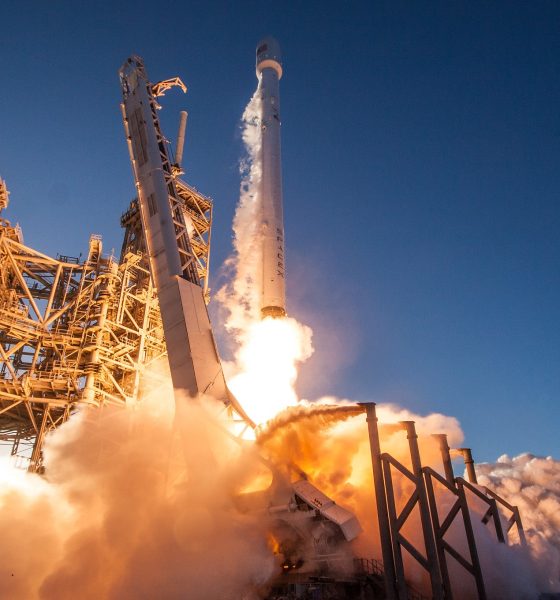

News
SpaceX set to launch massive satellite on July 2nd: 3 flights in 9 days
SpaceX’s Next Launch is Still Nearly on Time in Spite of BulgariaSat-1 Delays
As first reported earlier this morning by James Dean of Florida Today and now officially confirmed by the launch customer Intelsat, SpaceX’s launch of Intelsat 35e has been scheduled for July 2nd at 4:36 p.m. PST.
A several day delay of the launch of BulgariaSat-1 from Monday to Friday of last week was logically assumed to mean that the launch of Intelsat 35e, previously scheduled for July 1st, would be delayed at least several days to allow for the necessary pad checks and repairs that occur after launches. In 2017, this pad flow has generally taken at least a full week, with a static fire occurring once the pad is ready, and a launch several days after that. Two weeks has so far been a relatively consistent minimum between launches from the same pad.
A launch from LC-39A on July 2nd would give SpaceX at most nine days from the launch of BulgariaSat-1 to ready the pad once more. Further, Intelsat 35e has a static fire scheduled as early as Thursday this week, six days after the pad’s previous successful launch. I previously wrote about SpaceX potentially conducting three separate missions within the course of two weeks and declared that such an accomplishment would be a massive accomplishment and proof of concept for some of SpaceX’s more lofty goals. Now it would appear that there is a possibility that SpaceX could launch three separate missions in as few as nine days.
Nine days is of course quite close to being a single week, and successfully pulling off what is now officially scheduled would lend unassailable credence to a previous SpaceX goal of regular, weekly cadence by 2019. In fact, three launches in nine days from two separate pads almost makes regular weekly launches from two separate pads appear imminently in reach for the company, possibly even earlier than 2019.
Intelsat 35e will become the largest communications satellite SpaceX has ever sent to orbit, weighing in at ~6000 kilograms. Designed to last at least 15 years in geostationary orbit, it is expected that SpaceX will attempt to place the satellite into a higher energy geostationary transfer orbit in order to reduce the amount of time it takes the commsat to reach its final planned orbit. This translates to an expendable Falcon 9 Full Thrust that will pushed close to its payload and orbit limits. While it is now somewhat sad to see a Falcon 9 first stage unable to attempt recovery, this will still be a thoroughly exciting launch, especially considering the impressive mass of the satellite.

Another successful recovery for 1029 on June 23, 2017. Note the dramatic lean and differing angles of the legs on the left, courtesy of a very hard landing. (SpaceX)
SpaceX’s constant iteration of Falcon 9 vehicles meant that Intelsat 35e did not have to wait for Falcon Heavy, as the current default version of the Falcon 9 (v1.2) has begun to overlap the original performance estimates for the first Falcon Heavy concept. Of note, the vehicles that launched last weekend have approximately double the lifting capacity of the original Falcon 9, which last flew in 2013.
The static fire for the launch of Iridium 35e is currently scheduled for this Thursday. Check back at Teslarati for confirmation of that test as we find ourselves once more just a handful of days away from yet another SpaceX launch.

News
Tesla starts showing how FSD will change lives in Europe
Local officials tested the system on narrow country roads and were impressed by FSD’s smooth, human-like driving, with some calling the service a game-changer for everyday life in areas that are far from urban centers.

Tesla has launched Europe’s first public shuttle service using Full Self-Driving (Supervised) in the rural Eifelkreis Bitburg-Prüm region of Germany, demonstrating how the technology can restore independence and mobility for people who struggle with limited transport options.
Local officials tested the system on narrow country roads and were impressed by FSD’s smooth, human-like driving, with some calling the service a game-changer for everyday life in areas that are far from urban centers.
Officials see real impact on rural residents
Arzfeld Mayor Johannes Kuhl and District Administrator Andreas Kruppert personally tested the Tesla shuttle service. This allowed them to see just how well FSD navigated winding lanes and rural roads confidently. Kruppert said, “Autonomous driving sounds like science fiction to many, but we simply see here that it works totally well in rural regions too.” Kuhl, for his part, also noted that FSD “feels like a very experienced driver.”
The pilot complements the area’s “Citizen Bus” program, which provides on-demand rides for elderly residents who can no longer drive themselves. Tesla Europe shared a video of a demonstration of the service, highlighting how FSD gives people their freedom back, even in places where public transport is not as prevalent.
What the Ministry for Economic Affairs and Transport says
Rhineland-Palatinate’s Minister Daniela Schmitt supported the project, praising the collaboration that made this “first of its kind in Europe” possible. As per the ministry, the rural rollout for the service shows FSD’s potential beyond major cities, and it delivers tangible benefits like grocery runs, doctor visits, and social connections for isolated residents.
“Reliable and flexible mobility is especially vital in rural areas. With the launch of a shuttle service using self-driving vehicles (FSD supervised) by Tesla in the Eifelkreis Bitburg-Prüm, an innovative pilot project is now getting underway that complements local community bus services. It is the first project of its kind in Europe.
“The result is a real gain for rural mobility: greater accessibility, more flexibility and tangible benefits for everyday life. A strong signal for innovation, cooperation and future-oriented mobility beyond urban centers,” the ministry wrote in a LinkedIn post.
News
Tesla China quietly posts Robotaxi-related job listing
Tesla China is currently seeking a Low Voltage Electrical Engineer to work on circuit board design for the company’s autonomous vehicles.

Tesla has posted a new job listing in Shanghai explicitly tied to its Robotaxi program, fueling speculation that the company is preparing to launch its dedicated autonomous ride-hailing service in China.
As noted in the listing, Tesla China is currently seeking a Low Voltage Electrical Engineer to work on circuit board design for the company’s autonomous vehicles.
Robotaxi-specific role
The listing, which was shared on social media platform X by industry watcher @tslaming, suggested that Tesla China is looking to fill the role urgently. The job listing itself specifically mentions that the person hired for the role will be working on the Low Voltage Hardware team, which would design the circuit boards that would serve as the nervous system of the Robotaxi.
Key tasks for the role, as indicated in the job listing, include collaboration with PCB layout, firmware, mechanical, program management, and validation teams, among other responsibilities. The role is based in Shanghai.
China Robotaxi launch
China represents a massive potential market for robotaxis, with its dense urban centers and supportive policies in select cities. Tesla has limited permission to roll out FSD in the country, though despite this, its vehicles have been hailed as among the best in the market when it comes to autonomous features. So far, at least, it appears that China supports Tesla’s FSD and Robotaxi rollout.
This was hinted at in November, when Tesla brought the Cybercab to the 8th China International Import Expo (CIIE) in Shanghai, marking the first time that the autonomous two-seater was brought to the Asia-Pacific region. The vehicle, despite not having a release date in China, received a significant amount of interest among the event’s attendees.
Elon Musk
Elon Musk and Tesla AI Director share insights after empty driver seat Robotaxi rides
The executives’ unoccupied tests hint at the rapid progress of Tesla’s unsupervised Robotaxi efforts.

Tesla CEO Elon Musk and AI Director Ashok Elluswamy celebrated Christmas Eve by sharing personal experiences with Robotaxi vehicles that had no safety monitor or occupant in the driver’s seat. Musk described the system’s “perfect driving” around Austin, while Elluswamy posted video from the back seat, calling it “an amazing experience.”
The executives’ unoccupied tests hint at the rapid progress of Tesla’s unsupervised Robotaxi efforts.
Elon and Ashok’s firsthand Robotaxi insights
Prior to Musk and the Tesla AI Director’s posts, sightings of unmanned Teslas navigating public roads were widely shared on social media. One such vehicle was spotted in Austin, Texas, which Elon Musk acknowleged by stating that “Testing is underway with no occupants in the car.”
Based on his Christmas Eve post, Musk seemed to have tested an unmanned Tesla himself. “A Tesla with no safety monitor in the car and me sitting in the passenger seat took me all around Austin on Sunday with perfect driving,” Musk wrote in his post.
Elluswamy responded with a 2-minute video showing himself in the rear of an unmanned Tesla. The video featured the vehicle’s empty front seats, as well as its smooth handling through real-world traffic. He captioned his video with the words, “It’s an amazing experience!”
Towards Unsupervised operations
During an xAI Hackathon earlier this month, Elon Musk mentioned that Tesla owed be removing Safety Monitors from its Robotaxis in Austin in just three weeks. “Unsupervised is pretty much solved at this point. So there will be Tesla Robotaxis operating in Austin with no one in them. Not even anyone in the passenger seat in about three weeks,” he said. Musk echoed similar estimates at the 2025 Annual Shareholder Meeting and the Q3 2025 earnings call.
Considering the insights that were posted Musk and Elluswamy, it does appear that Tesla is working hard towards operating its Robotaxis with no safety monitors. This is quite impressive considering that the service was launched just earlier this year.








